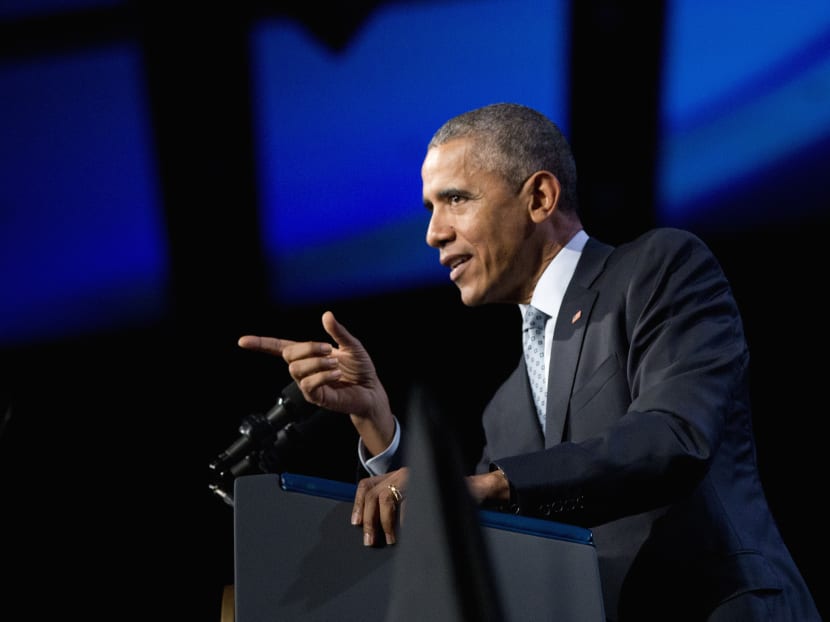With Syria deployment, Obama crosses own red line
WASHINGTON — Even as President Barack Obama sent US troops back to Iraq and ordered the military to stay in Afghanistan, he insisted Syria would remain off limits for American ground forces. Now the president has crossed his own red line.

In this Oct 27, 2015, photo, President Barack Obama speaks at the 122nd International Association of Chiefs of Police Annual Conference in Chicago. AP Photo
WASHINGTON — Even as President Barack Obama sent US troops back to Iraq and ordered the military to stay in Afghanistan, he insisted Syria would remain off limits for American ground forces. Now the president has crossed his own red line.
His deployment of up to 50 US special operations troops into northern Syria to assist in the fight against the Islamic State is the kind of incremental move that has defined Obama’s approach to the Middle East in his second term.
While the US military footprint in the region grows, each step is taken on a small scale so as to reassure the public that Obama isn’t plunging the country into another large, open-ended conflict.
The strategy may help ease Americans back into the realities of war, but regional experts as well as some of Mr Obama’s political allies say his slow ramp-up may be insufficient in defeating the fast-moving militants.
“Deploying a handful of US special operations forces to Syria will not change this situation significantly,” Mr Frederic Hof, Mr Obama’s former Syria special adviser, said of yesterday’s (Oct 30) announcement. “It is a Band-Aid of sorts”.
Senator Brian Schatz, a Democrat from Obama’s home state of Hawaii, said the latest escalation “is unlikely to succeed in achieving our objective of defeating IS and instead threatens to embroil the United States in Syria’s civil war.”
The military campaign against the Islamic State is nowhere near the size and scope of the wars in Iraq and Afghanistan. Obama has repeatedly used the costly and unpopular Iraq war in particular as an example of what he’s tried to avoid in the region.
But the significance of yesterday’s announcement was more about the location of the deployment, not the number of troops. It marks the first time the US has openly sent forces into Syria, expanding the geographic reach of Obama’s military efforts in the Middle East.
For years, the president has cast the chaos in Syria as exactly the type of situation he was elected to keep the US military out of. Washington has no partners in the Syrian government and few good options among opposition leaders. There is no ground force that the US can quickly train.
But the crisis has become unavoidable for Mr Obama, particularly since the Islamic State grew out of the chaos and crossed the border into Iraq. What the president could once cast as a civil war that needed to be solved by Syrians has threatened to upend the whole region.
Mr Obama’s first move was to deploy a few hundred US troops to Iraq to train and assist local forces in the fight against the Islamic State. It marked a return to Iraq for the US military after the 2011 withdrawal, which was a fulfilment of Mr Obama’s campaign promise to end the war he inherited from President George W Bush.
But over the past year, the number of US troops in Iraq has expanded to about 3,300. In another escalation, the US also began launching airstrikes against the Islamic State in both Iraq and Syria.
Despite killing as many as 12,000 militants, the bombing campaign has not significantly weakened the Islamic State’s capacity to hold territory, and the group’s ranks have been replenished by foreign fighters and others.
Mr Obama had hoped the strikes in Syria would be complimented by a ground force trained by Americans elsewhere in the region. But the train-and-equip program failed spectacularly and the president abandoned it earlier this fall.
The new US deployment into Syria essentially replaces that effort.
The decision allows Mr Obama — who has been under pressure by the Pentagon and international partners to make progress against the Islamic State — to contend he’s seeking new ways to address the crisis. The White House also argued the president wasn’t backtracking on his commitment to keep US troops out of Syria because the presence was narrow in size and scope.
But to some, the White House appears to be more concerned about being able to keep that political promise than in taking action that could have a more substantial impact in resolving the situation on the ground.
“War has a harsh reality in that in order to have an effect you have to be present,” said Mr Jerry Hendrix, a retired Navy flight officer and the director of the Defence Strategies and Assessments Program at the Centre for a New American Security.
The White House put no timetable on how long the American forces would stay in Syria, though Mr Obama has previously said he expects the campaign against the Islamic State in Iraq and Syria to last beyond his presidency.
The escalation of the Pentagon’s campaign against the Islamic State follows Mr Obama’s announcement two weeks ago that he was reversing course and keeping American troops in Afghanistan beyond next year.
That means the president who inherited two military conflicts will likely hand his successor three. AP






